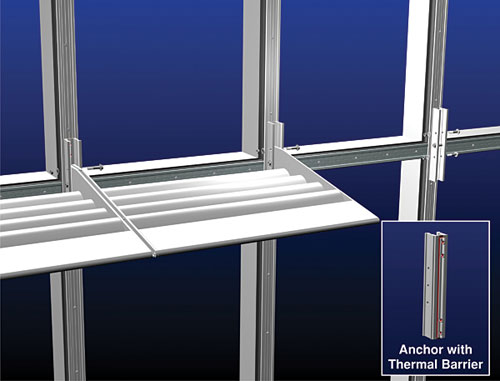Strategies for More Sustainable Exterior Solutions
STRATEGY #4: MEASURE 8:
Materials & Construction
Sustainable design includes the informed selection of materials and
products to reduce product-cycle environmental impacts, improve
performance, and optimize occupant health and comfort.
Exterior walls −curtain walls and sun shades
Harnessing sunlight requires integrated thinking. Designers must know the climate they are designing for, the orientation of the building and the angle of the sun at various times of the year, as well as educate building owners, operators and occupants. In addition, lowering the energy requirements of a building will also compensate for the energy lost through even high end insulating windows. Numerous studies show that humans are healthier and happier when they have adequate amounts of daylight and views, but in many climates, this can place an expensive burden on the thermal flow of the building.
Manufacturers are engineering new aluminum window systems and facades with high performing thermal properties. New façades can also incorporate thermal breaks into the anchors that attach exterior sunshade devices. Exterior sunshades control the sunlight entering a building by blocking the high sun angles in the hottest part of the year and allowing sunshine to enter the building when it is cold. A passive strategy that reduces the mechanical load on the building, sunshades are effective because they block heat rays from striking the building, reduce solar heat gain and thereby help lower energy consumption.
Sunshades also improve visual comfort for building occupants, reducing glare as well as adding to the overall aesthetic of the building façade. Integrating sunshades into aluminum curtain walls can be challenging. Adding sunshades to a structural system can often cause thermal bridging creating cold points that compromise the energy efficiency and condensation resistance of the system. Energy-efficient aluminum frames and sunshades are now being engineered to stop thermal bridging.
 |
Sunshade with thermal anchor as part of a façade system Photo courtesy of YKK AP America Inc. |
Â
When choosing an aluminum storefront, curtain wall, or its many components, architects should minimize the energy flow between the interior and the exterior by incorporating thermal barriers into the cladding systems. This can be done by specifying high performance systems that have good insulating properties (also knows as U-values). When selecting a thermal barrier the lower the thermal conductivity of the material the better the system's performance. A common error when integrating building envelope components is "short circuiting" the insulating properties of the system. An example of this is placing a framing system directly on the slab making the thermal barrier ineffective. Shimming the system from the base of the slab with low conducting materials, like high-impact shims, isolates the systems and improves the thermal performance of the building. Other components like sun shade devices must also be integrated with the curtain-wall or building system to prevent thermal bridging.
According to Mike Turner, Vice President of YKK AP America Inc., "In the past, architects could meet many building codes with just a single pane of glass, and no thermal barrier. Today, the aluminum industry is challenge to provide high performance storefronts, curtain walls, and window enclosures that maintain their structural integrity, provide good thermal performance and exceed the current codes in order to meet current and future challenges for energy savings."
One of the main challenges facing professionals is how to achieve carbon neutrality, or the design of a zero net energy building. The U.S. Department of Energy is encouraging research by providing funding for their goal to create marketable net zero initiatives by 2025.4 Net zero design initiatives mean that the project produces at least as much energy as it uses in a year. Near zero energy is a building that use some nonrenewable energy generation as a backup.
Structure, air, water, energy − these are the performance areas that are critical for frame manufacturers. Frames have to have structural integrity and meet new building codes that provide protection from hurricanes. They may also provide blast mitigation as well as meet high standards for energy performance. Sometimes the codes conflict − for example, the heavier material required for security may not be optimal for good thermal performance unless a thermal barrier is incorporated. Heavier glass required for security installations may also mean thicker, heavier frames to support the heavy dead loads, increasing the cost of the product. Different climates can also create different challenges for insulation, thermal performance and finishes.
A comprehensive evaluation of the requirements must be made to ensure the systems meet all of the requirements of the building structure. The American Architectural Manufacturers Association (AAMA) provides guidance on window performance in the AAMA 101/A440 standard. Window products classified with an AW Class designation are required to pass performance tests for air infiltration, water infiltration and structural performance as well as life cycle tests to ensure the products will stand up to the needs of the commercial market.
Aluminum is now one of the most recycled products used in manufacturing. Aluminum has a long life cycle Sunshade with thermal anchor as part of a façade system and can be recycled over and over again and still maintain structural stability. Using recycled aluminum means that the manufacturer uses only 5 percent of the energy that would have been used in raw Aluminum products. Architects are now specifying recycled content from manufacturers with very little additional costs for the system in order to meet LEED® requirements and to reduce the use of raw materials.
The new aluminum sunshade with a thermal break is one of the first aluminum products to have cradle to cradle (C2C) certification. C2C certification is defined as the evaluation of the eco-effectiveness of a product by assessing the materials used in its production as well as the production process itself, including the use of renewable energy, water conservation and stewardship, and the manufacturers' social responsibility.5 Manufacturers are well on their way to solving the issues of structural and energy efficiency to meet future codes.









